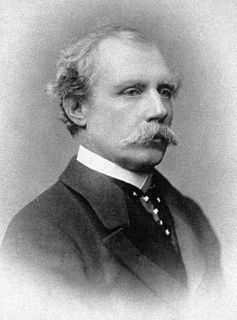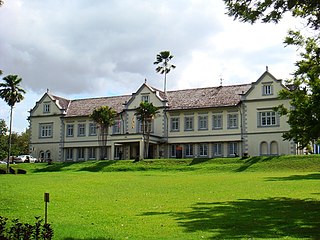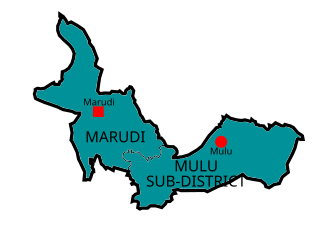The Brooke family is an English family that ruled the Raj of Sarawak from 1841 until 1946.
Rajahs of Sarawak:
- James Brooke (1841–1868)
- Charles Brooke (1868–1917)
- Charles Vyner Brooke (1917–1946)
The Brooke family is an English family that ruled the Raj of Sarawak from 1841 until 1946.
Rajahs of Sarawak:

Sir James Brooke, Rajah of Sarawak, was a British soldier and adventurer who founded the Raj of Sarawak in Borneo. He ruled as the first White Rajah of Sarawak from 1841 until his death in 1868.

Sir Charles Brooke, Rajah of Sarawak, GCMG, born Charles Anthoni Johnson, ruled as the head of state of Raj of Sarawak from 3 August 1868 until his death. He succeeded his uncle, James Brooke, as the second White Rajah of this small country on the coast of Borneo.

Vyner, Rajah of Sarawak, GCMG, full name Charles Vyner de Windt Brooke was the third and last White Rajah of the Raj of Sarawak.

The White Rajahs were a dynastic monarchy of the British Brooke family, who founded and ruled the Raj of Sarawak, located on the north west coast of the island of Borneo, from 1841 to 1946. The first ruler was Briton James Brooke. As a reward for helping the Sultanate of Brunei fight piracy and insurgency among the indigenous peoples, he was granted the province of Kuching, which was known as Sarawak Asal in 1841 and received independent kingdom status.

Sibu Division is one of the twelve administrative divisions of Sarawak, Malaysia. It has a total area of 8,278.3 square kilometres, and is the third largest division after Kapit Division and Miri Division.
Tun Datuk Abang Haji Openg bin Abang Sapiee was a Malaysian politician who served as the first Yang di-Pertua Negeri of Sarawak from September 1963 to his death in March 1969. He assumed the newly established post following Sarawak's independence from the Great Britain and the formation of Malaysia in 1963.

The flag of Sarawak, a state of Malaysia, is based on the flag of the Raj of Sarawak of the White Rajah, and includes the yellow of Southeast Asian royalty — a similar yellow and diagonal black are in the flag of Brunei, although Brunei's yellow is of a brighter shade.

The dollar was the currency of the Raj of Sarawak from 1858 to 1953. It was subdivided into 100 cents. The dollar remained at par with the Straits dollar and its successor the Malayan dollar, the currency of Malaya and Singapore, from its introduction until both currencies were replaced by the Malaya and British Borneo dollar in 1953.

The Raj of Sarawak, also State of Sarawak, located in the northwestern part of the island of Borneo, was an initially independent state that later became a British Protectorate in 1888. It was established as an independent state from a series of land concessions acquired by an Englishman, James Brooke, from the Sultan of Brunei. Sarawak received recognition as an independent state from the United States in 1850, and from the United Kingdom in 1864. The area now forms the Malaysian state of Sarawak.
Rentap (1800–1863) was an Iban-Dayak warrior and a recognized Iban hero in Sarawak during the reign of the first White Rajah, James Brooke. His praisename, Rentap Tanah, Runtuh Menua translates from the Iban language as 'Earth-tremor, World-shaker'. His famous and frequently quoted slogan was "Agi idup, Agi ngelaban" which translates into "Still alive, still fighting".
Charles Brooke may refer to:

The Sarawak State Museum is the oldest museum in Borneo. It was founded in 1888 and opened in 1891 in a purpose-built building in Kuching, Sarawak. It has been said that naturalist Alfred Russel Wallace encouraged Charles Brooke, the second White Rajah of Sarawak, to establish the museum: there is no evidence for this.

Marudi is a town in the Malaysian state of Sarawak, and is a part of the division of Miri. It is the seat of Marudi District, and is located on the banks of Baram River, about 100 kilometres (62 mi) upstream from the river mouth. Marudi was the administrative centre of the northern region of Sarawak before Miri was established. Marudi is considered as the cultural heart of the Orang Ulu, the highland tribes of Sarawak. It is also a transit gateway to Gunung Mulu National Park, a UNESCO World Heritage Site.

Sylvia Leonora, Lady Brooke, Ranee of Sarawak, was an English aristocrat who became the consort to Sir Charles Vyner de Windt Brooke, Rajah of Sarawak, the last of the White Rajahs.

The History of Sarawak can be traced as far as 40,000 years ago to the paleolithic period where the earliest evidence of human settlement is found in the Niah caves. A series of Chinese ceramics dated from the 8th to 13th century AD was uncovered at the archeological site of Santubong. The coastal regions of Sarawak came under the influence of the Bruneian Empire in the 16th century. In 1839, James Brooke, a British explorer, first arrived in Sarawak. Sarawak was later governed by the Brooke family between 1841 and 1946. During World War II, it was occupied by the Japanese for three years. After the war, the last White Rajah, Charles Vyner Brooke, ceded Sarawak to Britain, and in 1946 it became a British Crown Colony. On 22 July 1963, Sarawak was granted self-government by the British. Following this, it became one of the founding members of the Federation of Malaysia, established on 16 September 1963. However, the federation was opposed by Indonesia, and this led to the three-year Indonesia–Malaysia confrontation. From 1960 to 1990, Sarawak experienced a communist insurgency.
Vice-Admiral Basil Charles Barrington Brooke was an English admiral and cricketer, who also played for the Singapore national cricket team. He played twice for the Royal Navy Cricket Club in first-class cricket. A member of the Brooke family which ruled the Kingdom of Sarawak from 1841 to 1946, he commanded the battle cruiser HMS Renown during the Second World War.

The anti-cession movement of Sarawak was a movement in Sarawak to fight against the British attempt to govern Sarawak as a crown colony rather than a protectorate ruled by the White Rajahs. The movement lasted from 1 July 1946 until March 1950.
Brooke is a surname. Notable people with the surname include:

The Crown Colony of Sarawak was a British Crown colony on the island of Borneo, established in 1946, shortly after the dissolution of the British Military Administration. It was succeeded as the state of Sarawak through the formation of the Federation of Malaysia on 16 September 1963.

The Kuching Old Courthouse is a historical courthouse in Kuching, Sarawak, Malaysia.